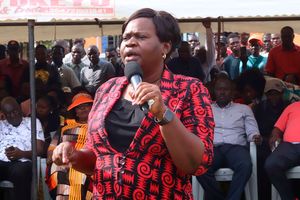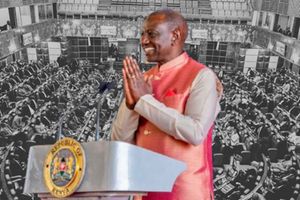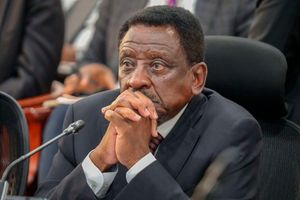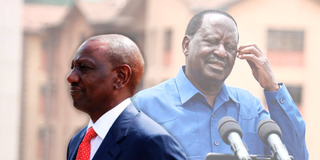
The Ruto-Raila pact has had ripple effects beyond political partnerships.
Up until June 2024, whenever the ODM party or its leader, Raila Odinga, sought to address the nation on any pressing matters, it would be characterised by hard-hitting statements that instantly attracted the ire of State functionaries.
Mr Odinga kept the government on its toes, and for that, the veteran opposition leader was often accused of sabotaging the State — sometimes even of working with foreign powers to foment dissent.
On occasions when the party called for street protests in Nairobi or other major towns, business would grind to a halt.
At one point, National Treasury mandarins estimated that the economy was losing at least Sh2 billion daily during such protests.
He had become such a thorn in President William Ruto’s side that, had he joined forces with the Gen Z protesters last June, the president's supporters agree that he would have brought down the Kenya Kwanza administration.
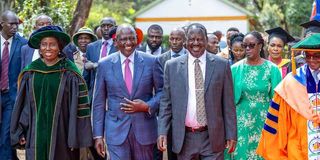
President William Ruto and former Prime Minister Raila Odinga arrive for the installation of Dr Bernard William Chitunga as the second Chancellor of the Co-operative University of Kenya in Karen, Nairobi, in April.
Also Read: Opposition within: Ruto, Raila clash
Consequently, a strategy had to be devised to achieve two missions: bring him on board to help Dr Ruto at a time of crisis and neutralise him by any means necessary. And soft power became the tool of choice.
Today, the Orange Democratic Movement (ODM) — formed in 2005 after Mr Odinga led more than half of Cabinet to oppose a proposed constitutional referendum whose ‘No’ symbol was an orange—is seen as an extension of the government, despite its leadership's concerted denials that they are not part of it and have only given out “experts” (Cabinet secretaries) in the broad-based government arrangement. They are not spared the curse of the Kenya Kwanza regime's incumbency.
On social media, Mr Odinga is often depicted alongside the President, being hanged for anything perceived as failing, from healthcare to the rising cost of living.
Critics do not miss an opportunity to remind Mr Odinga’s supporters that John Mbadi, the man in charge of the country’s public purse, was the ODM chairman until his appointment last year.
“This support wasn’t just about continental ambitions,” says political analyst Dr Isaac Gichuki, referring to Dr Ruto’s support for Mr Odinga’s failed bid to become African Union Commission chair in February 2025.
He adds: “It was a calculated move by Ruto to neutralise Raila’s influence domestically. In turn, Raila’s cooperation effectively dismantled the opposition as we knew it.”
The Ruto-Raila pact has had ripple effects beyond political partnerships.
Following last year's Gen Z-led protests, which shook the government's foundations, Dr Ruto sought Mr Odinga’s support to stabilise his administration. In exchange, ODM leaders were offered State positions.
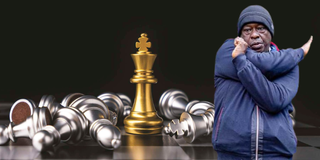
Former Deputy President Rigathi Gachagua is strategically positioning himself as a political hero.
Political chess
Meanwhile, Dr Ruto moved to sideline his deputy, Rigathi Gachagua, fuelling speculation of a power struggle that ultimately resulted in impeachment and consignment of his abrasive number two to the opposition.
“This was Ruto’s endgame,” says Dr Gichuki. “By drawing Raila into government and isolating Gachagua, he split the opposition and consolidated control. But, ironically, it also sowed the seeds for a new, potentially more volatile opposition.”
There’s a part of Mr Odinga that is sometimes alive to the curse of being associated with incumbent regimes — a plague he has suffered before — and his handlers say this is why he has said, “We’re not in government; we’ve only donated experts to Ruto”, in order to keep at least one leg outside.
This gives him the flexibility to distance himself from Kenya Kwanza when convenient, according to observers.
What the President has achieved, either intentionally or not, is to stoke an internal feud within ODM. It’s now a house divided against itself.
An ensuing crisis of public divisions is tearing at the heart of the juggernaut formed two decades ago on the back of the 2005 referendum victory against the proposed constitution.
In addition to Mr Mbadi (Treasury), the Cabinet includes the former party deputy leaders Wycliffe Oparanya (Cooperatives and MSMEs), Hassan Joho (Mining and Blue Economy), former Secretary of Political Affairs Opiyo Wandayi (Energy) and Beatrice Askul (East African Community and Asal).
Party members have also benefited from key, powerful parliamentary committees, such as the Health and Budget and Appropriations Committees, currently chaired by James Nyikal (Seme) and Samuel Atandi (Alego Usonga), respectively.
Secretary-General Edwin Sifuna has clarified that ODM's involvement in government affairs through advisory roles and appointments does not constitute formal participation in governance.
"Baba (Mr Odinga) told me that even after we donated our experts to the government, ODM is not in government,” Mr Sifuna said. “If ODM is not in government, the ODM secretary-general cannot be in government.”
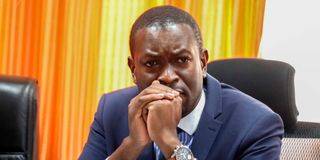
Nairobi Senator Edwin Sifuna follows proceedings during a hearing of the Senate Energy committee at Parliament Buildings in Nairobi on Thursday last week.
During the signing of the Memorandum of Understanding between the ruling UDA and ODM in March, President Ruto praised Mr Odinga for the sacrifices he has made for “the country’s best interest”.
The President's intention to control ODM became apparent when he courted party rebels prior to the MoU with Mr Odinga. The rebels included Gideon Ochanda (Bondo), Elisha Odhiambo (Gem), Mark Nyamita (Uriri), Caroli Omondi (Suba South), Shakeel Shabbir (Kisumu East, Independent), Felix Odiwuor (Jalang'o, Lang'ata), Paul Abuor (Rongo), John Owino (Awendo), and Kisumu Senator Tom Ojienda, who began supporting him as early as 2023.
By bringing Mr Odinga on board, Dr Ruto has won over the ODM brigade, including those in Parliament who have been defending the broad-based government as if it were their own.
Orengo catch
The latest catch is Siaya Governor James Orengo. On Thursday, he led a delegation from his county to the State House, which is a dramatic change of stance from his earlier view that one does not have to kowtow to the Executive to secure development.
Mr Orengo has publicly accused his ODM colleagues of joining the “praise and worship” team of President Ruto’s administration.
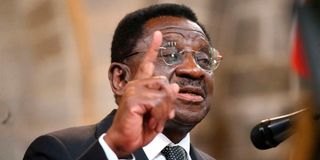
Siaya Governor James Orengo.
The former ODM Secretary-General and Kisumu Governor Anyang' Nyong'o is also among those who have joined the fold. He and Mr Orengo are among the few people with the gravitas to challenge Mr Odinga within the party.
On Wednesday, Prof Nyong'o released a statement praising the government for the ongoing development projects in his county.
“We wholeheartedly support the decision by President Ruto and Raila Odinga to work together in the interest of national unity and development.
"As a county, we stand firmly behind the vision outlined in the recently signed MoU that underpins the broad-based government,” said Prof Nyong’o, encouraging the President and Mr Odinga to continue with their joint tours across the country.
Following the visit to the State House, the President announced major projects for Siaya.
The Head of State said the government would invest at least Sh1 billion in the blue economy, including Sh600 million for Usenge Pier and its associated port facilities, Sh400 million for a fish market, among others.
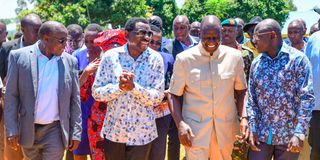
President William Ruto (second right) with Siaya Governor James Orengo and other leaders during the groundbreaking ceremony for Urenga Level IV Hospital in Ugenya, Siaya County on Friday, October 6.
Dr Ruto also promised the leaders that the government would complete the stalled projects at the Jaramogi Oginga Odinga University of Science and Technology. The aim is to make Nyanza as comfortable as possible in the hope that they will not turn their backs on him again.
The schism within Mr Odinga’s camp reflects the fundamental tension between political survival and ideological purity.
It pits those who favour compromise against those who favour ideological purity. These are ministers, governors, and MPs who have benefited from Ruto’s patronage.
They argue that continued cooperation offers them a micro-opportunity to demonstrate how an ODM government would function. Opposing them are the party loyalists who view an alliance with the ruling United Democratic Alliance (UDA) as an existential threat to Mr Odinga’s standing and the party's future.
Unlike past internal disputes, the current conflict is unfolding openly in press conferences, social media spats and competing public declarations, with the two factions advancing opposite visions for the future of the ODM.
At the funeral of the late Kasipul MP Charles Ong’ondo Were, the opposing camps openly pitched their positions, prompting Mr Odinga to caution the party secretary general, Edwin Sifuna, to temper his “sting”.
ODM now functions like a schizophrenic political party — it is slapping the government while the right hand on a firm handshake with Dr Ruto.
Both fighting camps pledge their allegiance to Mr Odinga. The crux of the matter is whether their leader should continue his broad-based government alliance with President Ruto or break off and prepare to run against him in 2027.
There is an even more profound fear that if he doesn’t run, the party’s stature may diminish further after the elections.
Besides, UDA has made considerable inroads in ODM’s strongholds, a matter that has got a section of the Orange party leadership worried.
This recently prompted Homa Bay Governor Gladys Wanga to warn against encroachment into ODM zones and inadvertently laying bare the dilemma presented to the 20-year-old party.


